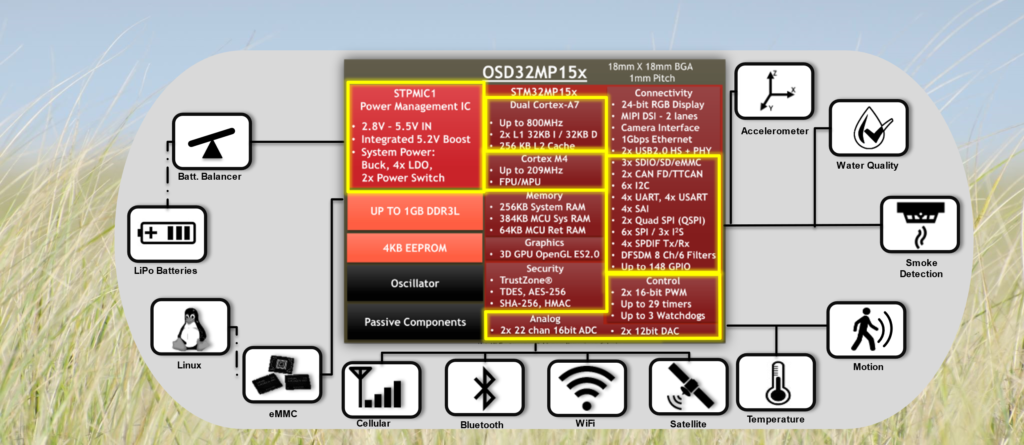Related Products
Remote Sensor Node with the STM32MP1 System-in-Package
Published On: April, 21, 2022 By: Greg Sheridan
Sensors are becoming more and more ubiquitous with the internet of things (IoT) and our desire to make decisions and take actions based on data collected from around us continues to grow. Whether it be cameras, temp sensors, lidar systems, sonic detection, pressure, or any of thousands of different sensor types, they provide us important information about our environment that we can use to make decisions. More and more of these decisions are being made by AI algorithms that require even more data from even more sensors.
Typically, when we think of sensors we think of temperature or motion sensors in our house, weight and optical sensors in a factory, or security cameras around our neighborhood. All these sensors have a direct connection to a constant power source and able to communicate to the central processing system through a consistent reliable connection.
However, what happens when our senor nodes move outside of the nice confines of reliable power and telemetry? The sensor now needs to be self-contained and robust able to handle no or intermittent telemetry and no reliable source of power, they need to become their own nodes. These remote sensor nodes can be used to monitor environmental conditions in remote parts of the world, watch for wildlife in the jungle, monitor for radiation or other harmful contaminates, or be used to capture seismic data for earthquake research or oil and gas exploration. The options are endless.
The OSD32MP1 System-in-Package is the perfect controller for a remote sensor node. It integrates the, STM32MP1 from ST Microelectronics, STPMIC1 Power Management IC, up to 1GB of DDR3 memory, EEPROM, and passive components into a single 18mm X 18mm BGA package. The integrated SM32MP1 supports a wide variety of I/O protocols allowing it to connect to just about any sensor available. It’s I/O and ability to run Linux also make it easy to manage long term storage of data and a number of different networking protocols. Also, the integrated efficient PMIC has a wide input voltage allowing it to easily run of lithium polymer batteries for an extended amount of time.
A PDF of this Application Note can be downloaded here.
The OSD32MP15x
Here are some of the highlights of the OSD32MP15x that make it an ideal fit for a remote sensor application while also speeding up your design of it:
Low Power M4 Microcontroller
The on-die Arm Cortex M4 Microcontroller, on the STM32MP1, enables low power data capture from connected sensors, without the need for the A7s, providing longer battery life and continuous monitoring.
Efficient Dual A7 Microprocessor
Optimize your data for storage or transfer by performing data compression or analysis on the dual Cortex A7 cores capable of running up to 800MHz. Store and send just the critical data needed.
Wide Variety of Digital I/O
With support for everything from I2C, to SPI, to UART, to SPDIF, to CAN, to over 140 GPIO, the OSD32MP1 can interface with almost any digital sensor available.
Analog I/O
Use the 16-bit ADCs as well as the 12-bit DAC to drive and capture data from a wide array of analog sensors.
Connectivity
Whether your system requires Cellular, Satellite, Bluetooth, Wi-Fi, USB, Ethernet, or some other communication protocol, to get your data to the central processing center. The OSD32MP1 supports them all.
Efficient Power Supply
The integrated STPMIC1 is an efficient power supply with a wide input voltage that is capable of being powered by LiPO batteries.
Secure
The sensor data collected is valuable and needs to be protected. The OSD32MP1x supports secure boot, and trusted execution space. It also includes hardware accelerators for AES, SHA, and random number generation enabling the encryption of the collected data for storage and transmission to the remote data center.
Full Linux Support
Leverage the breadth of the Linux community to quickly get your system running. No need to write drivers for different sensors or handle complex networking stacks, let Linux handle it for you. The OSD32MP1x is completely supported in mainline Linux.
Robust Solutions
The OSD32MP1x is built to work in the harshest environments. It is rated to work in temperatures ranging from -40°C to 85°C. Also, its plastic encapsulated mold makes it able to withstand the highest vibration environments.
Faster Time to Production Floor
The OSD32MP1 makes designing with a flexible and powerful Linux capable processor as easy as working with a Microcontroller. Spend less time getting the processor to work and more time focused on developing your application.
Get Started Today:
You can get started today by leveraging one of Octavo Systems open hardware development platforms. We recommend starting with either the OSD32MP1-BRK, flexible prototyping platform, or the OSD32MP1-RED, which is a fill featured development platform.
Learn More
Want to learn more? Contact us.
You can also sign up for our Mailing List to get the latest information on System-in-Package:
"*" indicates required fields

